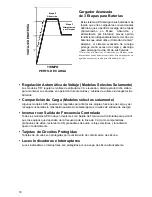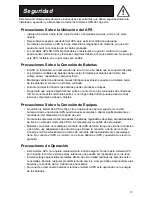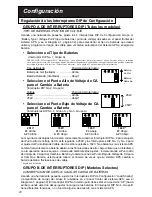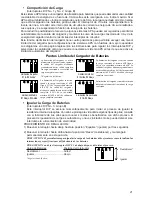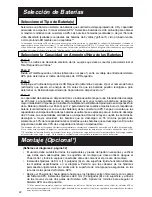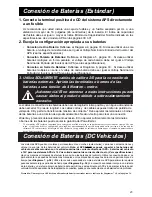
9
AC Connection
Before AC connection, match the power requirements of your
equipment with the power output of your APS to avoid overload.
When figuring the power requirements of your equipment, do not confuse “continuous” power
ratings with “peak” power ratings. Electric motors require more power to turn on (“peak power”)
than they require to run continuously. “Peak” power ratings are usually 2 to 5 times “Continuous”
ratings. Most electric motors require “peak power” only when they are first turned on. The electric
motors in equipment such as refrigerators and sump pumps, however, constantly turn on and off
according to demand. These motors require “peak power” at multiple, unpredictable times during
their operation.
Hardwired Electrical Connections
(All hardwire models)
(See Diagram 3, p. 32).
Consult a qualified electrician and follow all applicable electrical codes and requirements.
HARDWIRE PROCEDURE
1) Remove screws and cover plate from your APS’s Hardwire AC electrical box. Remove the
knockout covers closest to the desired electrical source and to your equipment.
2) Thread your wires through strain reliefs and through the knockouts.
3) Connect all input and output ground wires to the input/output ground tie point.
4) Connect the incoming hot wire to the input hot (brown) terminal.
5) Connect the incoming neutral wire to the input neutral (blue) terminal.
6) Connect the outgoing hot wire to the output hot (black) terminal.
7) Connect the outgoing neutral wire to the output neutral (white) terminal.
8) Tighten and affix strain reliefs. Replace cover plate and tighten screws.
AC Input Electrical Connection
(All corded models)
This IEC receptacle should be connected to a dedicated 15 Amp AC utility outlet that provides a
connection to ground. A detachable IEC cord is provided for this purpose. Plug it into an outlet pro-
viding 230V AC power at 50 Hz. A user-supplied adapter that maintains the UPS’s connection to
ground may be necessary. (A technician may be able to convert your APS to receive 60 Hz. power.
Consult Tripp Lite for details.) Make sure that the circuit you connect your APS to has adequate
overload protection, such as a circuit breaker or a fuse.
AC Output Electrical Connection
(All corded models)
Simply plug your equipment into the unit's AC receptacles. If adapters must be used, choose
adapters that provide a connection to ground.
Set Operating Mode Switch
• Switch to “AUTO/REMOTE” when you are using connected equipment. ADVANTAGE:
Uninterruptible power supply. Provides battery backup power during blackouts or brownouts.
Note: When the switch is in the “AUTO/REMOTE” position, you can operate a user-supplied
switch to transfer between battery-backup and charge-only modes. (See Remote
Connector manual for more information.)


















